Contrary to popular belief, Baselworld is not just a steady stream of tourbillons, chronographs, and watches that are mostly black. The show does play host to some individualists who create watches that are outside the mainstream. Some are newcomers, and some return year after year, reliably delighting us with their unique vision. We take a look at a few of their creations.
One of our favorite newcomers this year is Breva. The brand’s watch is the Génie 01, a stylish and original mechanical mini-weather station for the wrist.
Breva was founded by a young entrepreneur named Vincent Dupontreué. Born near Paris in 1977, at age 11 he was selling bracelets at the beach, and at 13, skateboard ramps. At 22, he launched an eponymous fashion brand which he sold seven years later. After he earned an MBA in Switzerland and ran an art gallery, his desire to own a unique timepiece, and his inability to find just the right one, led him to launch his own watch brand. The brand’s name was inspired by a beautiful weekend he once spent on Lake Como in northern Italy. “La Breva” is a warm wind that contributes to the lake’s agreeable micro-climate. The weekend at the lake also inspired the idea for a mechanical watch that could forecast the weather. Dupontreué did his homework and found the watchmaker Jean-François Mojon and the company he started, Chronode, both familiar to fans of creative horology. Dupontreué designed the overall look of the watch, and Mojon the movement. Three years of R&D led to the Génie 01, which manages to look like something from the past and something from the future at the same time. Breva claims that it is the world’s first watch with mechanical time, altimeter, and barometer, plus a power-reserve display.
The open, transparent design serves up layers of displays, and though there’s a lot going on, the watch is easy to read. Hours and minutes are displayed on a tinted, semi-transparent subdial at 8 o’clock. Small seconds are positioned below 12 o’clock. The altimeter display arcs around the perimeter in the upper left quadrant of the display. Barometric pressure is indicated on a second tinted subdial at 2 o’clock, where a single hand points to icons representing forecast sunny, cloudy, and stormy conditions. There is a 65-hour power-reserve indicator at 4 o’clock. An anaerobic capsule measuring air pressure dominates the lower portion of the dial, with another identical capsule underneath it to maximize sensitivity. The crown at 9 o’clock handles winding and time setting. At 2 o’clock, a knurled exterior ring adjusts the barometric pressure scale, while an inner pusher adjusts the position of the altitude indication. At 4 o’clock, a crown with a knurled locking ring rotates 90 degrees to lock and unlock an air valve. An osmotic Teflon membrane filters out moisture.
The sapphire caseback features a circular scale engraved around the perimeter providing correlations between altitude and air pressure. The Génie 01 is a limited edition of 55 pieces in white gold priced at $155,000, and 55 pieces in 4N rose gold priced at $150,000. Breva tells us that it is not a one-trick pony. More watch projects are in the pipeline. The forecast looks good. (Click here to watch a video of the Breva Genie 01.)
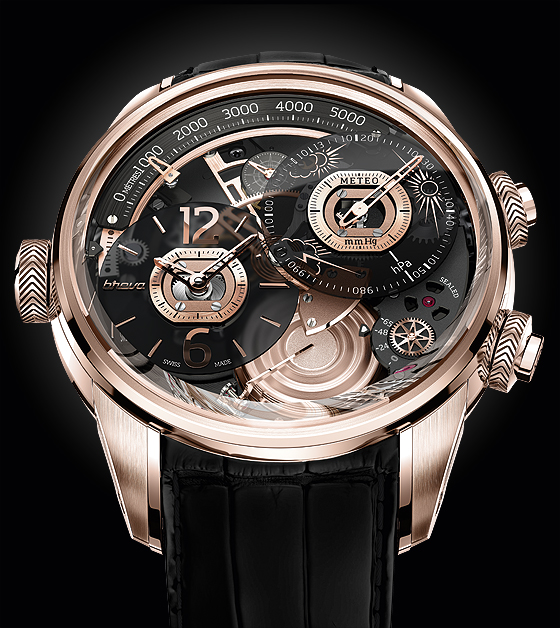
Another relative newcomer, attending its second Baselworld this year, is Nord Zeitmaschine. Nord is a geographical reference to the north of Switzerland, where company founder Daniel Nebel was born and where he has been making timepieces since 1998. Zeitmaschine, of course, means “time machine.” Nebel did not take the traditional path to watchmaking. His background is machining, which is watchmaking if you consider making dials, cases, screws and crowns making watches. Within that world, his specialties include making tools and prototypes. He started studying watches in 1995. Over time, he began producing wheels, pinions, plates, bridges, and hands. He completed his first watch in 1998. Since then, he has expanded both his knowledge of watches and his workshop.
Interested in innovative time displays, in 2011 Nebel modified an ETA 2824 caliber to create a watch called the Variocurve. Nebel wanted to abandon the concept that hands have to turn on a fixed axle, which leads to the time always being displayed on a constant radius. After many experiments, he came up with an oversize minutes hand powered by two counter-rotating eccentric cams. The hand, which dominates the display, appears to grow longer and shorter as it traces two sweeping minutes-track arcs across the dial – one near the perimeter at the top of the dial, and the other just below the first. In an added twist, numbers that are not included at the ends of the minutes tracks are supplied by twin rotating disks. The hours are displayed on a rotating disk located at 8 o’clock, and the date on another disk at 4 o’clock.
This year, three weeks before Baselworld to be precise, Nebel completed a prototype for a new zeitmaschine, this one called the Quickindicator, and the concept plays a trick on your mind. Nebel claims that the watch has the world’s fastest-moving minutes hand. You might think “Hold on. If the hand goes around the dial faster, then it must make the trip in less than 60 minutes.” And you would be right. But what if the hand has to go around the dial more than once to measure 60 minutes? That’s the concept behind this watch. Nebel says that if you take a traditional minutes track that circles a typical watch dial and lay it out as a straight line, it measures about 88 mm in length. So a traditional minutes hand travels 88 mm in one hour. It’s not hard to imagine a minutes track with a more complex shape that is longer than 88 mm. Indeed, the minutes track on the Quickindicator is 204.8 mm long. The layout, which resembles two smaller overlapping circles inside a larger circle (though none of them is precisely round) means that Nebel’s minutes hand must travel 360 degrees three times, with each trip taking 20 minutes, to measure a single hour. The three 20-minutes tracks are not concentric, so, as on the Variocurve, the minutes hand does not turn on a fixed point, but wanders around the dial. The hours are displayed on a rotating disk at 9 o’clock, and the date on a disk at 3 o’clock.
The Quickindicator is available in three versions, priced at about $15,000.
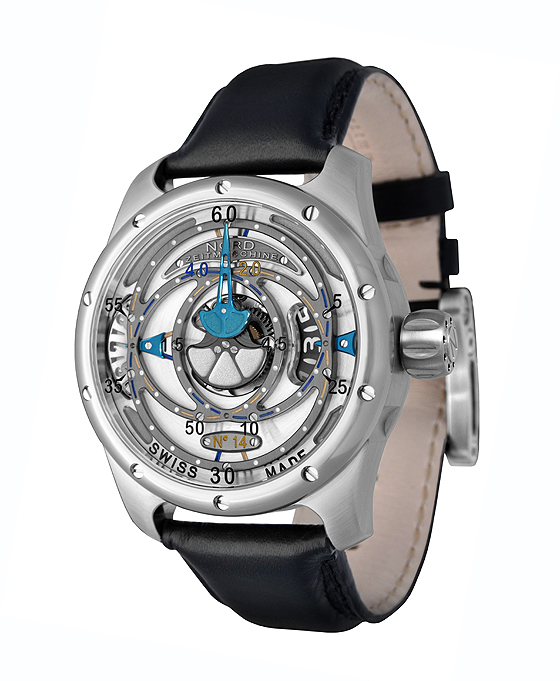
Our next creative mind is Valerii Danevych, and some of you may remember him as the woodcarving watchmaker from Kiev.
As we reported last year, Danevych and his wood wristwatch with tourbillon caused quite a stir. A third-generation woodcarver and a cabinetmaker by profession, Danevych is entirely self-taught. He began by copying grandfather clock movements in wood, progressing from there to smaller and more complicated pieces. He makes many of his own tools, as none exist that suit his unique needs. The smallest part he has made has a diameter of 0.1 mm. His wristwatches are entirely wood, save the mainspring and balance spring. Occasionally he incorporates mother-of-pearl, amber, and even mammoth tusk for decoration. Some watches also have crystals to protect the mechanism. His organic creations keep time to within two to three minutes per day. Many collectors are happy if their vintage pocketwatches perform that well. This year, Danevych showed a new one-minute tourbillon wristwatch with a double-retrograde display. The piece required 1,800 hours, over a period of seven months, to produce. The case measures 46 mm without the crown and it is 18 mm thick. The complete watch weighs just 32 grams. The movement has 154 parts made from eight types of wood, and it uses a traditional anchor escapement. In the photo shown here, the amazingly detailed escape wheel is visible on the right side of the dial aperture. There are eight springs, four made of metal and four of bamboo. The movement winds manually, and the power reserve is 24 hours. Danevych cautioned that though he uses hardwoods, his wristwatches are not intended for daily use.
The watch has a single track displaying both hours and minutes. A small, light-color indicator above the track marks the hours, while a more traditional, center-mounted hand denotes the minutes. In the top photo, the time is about 2:36. Both indicators move in retrograde fashion, snapping back to their starting positions at the end of each trip down the track. You would not think it possible, but if you look closely, the hour and minutes track actually contains a hand-carved typo: the numeral XIII. That piece must have been carved late at night, just before Baselworld opened. Danevych says he will fix it before selling the watch. Speaking of selling, Danevych told us that he consulted a Patek Philippe expert before setting the price. It’s €100,000, and if you buy it, you will have a unique piece, in more ways than one.
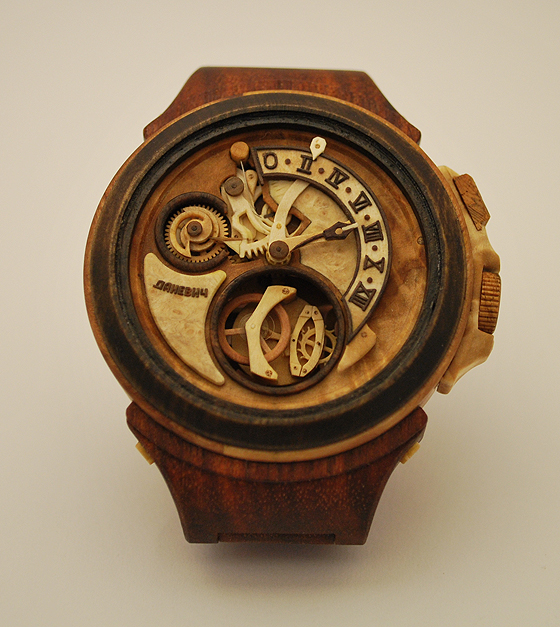
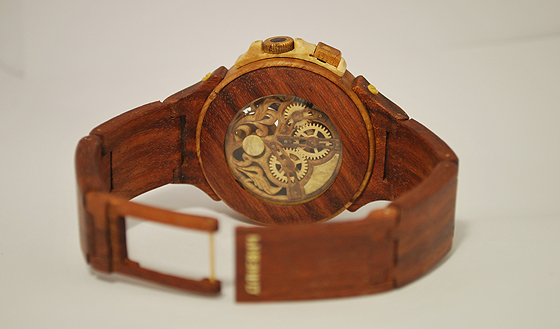
Stefan Kudoke is the man to see if you want to put an octopus on your wrist. He has an impressive résumé. Kudoke (pronounced koo DOH kah), received his master craftsman in watchmaking certificate with honors at age 22. He refined and expanded his skills working in the studio for complications and prototypes at Glashütte Original, then in the after-sales service departments at Breguet, Blancpain and Omega in New York. But like most who choose the path less traveled, he was not entirely satisfied working for big brands, even those with impressive names and histories. He really wanted to create his own watches. He’s been doing that since 2008.
Despite his training, Kudoke does not make his own movements from scratch. Rather, he skeletonizes and engraves, makes dials and hands, and otherwise transforms the prosaic into the unique. He often works with tried and true tractors like the ETA 2824-2 and 6498.Kudoke also works with other independent watchmakers, adding his special flair to their work. The watch that caught our eye in the Baselworld Palace, a building separate from the main watch hall and housing many independent brands, is the product of a collaboration with Austrian watchmaker Richard Habring. It’s a distinctive timepiece with an equally distinctive name: the KudOkTourbi, which is a collapsed version of Kudoke Oktopus Tourbillon (oktopus is the German spelling). Kudoke begins with Habring’s H2 Flying Tourbillon. He skeletonizes and engraves the movement by hand, animating it with a creature from the deep whose tentacles form the hands as well as the plate and bridges, creating the impression that the octopus is embracing the movement, wrapping around it from front to back. The octopus is finished in rose gold. The KudOkTourbi will be produced in a limited edition of eight pieces, priced at €29,000 (including 19 percent VAT).
If you prefer something simpler, a non-tourbillon version, called the KudOktopus, is also available. Due to this watch’s uncluttered dial, the octopus motif is more clearly visible. It is also hand-skeletonized and engraved and the wheels are plated with black rhodium. It is priced at €7,990 (including VAT). Both models are 42 mm in diameter, and both use movements based on the Unitas 6498.
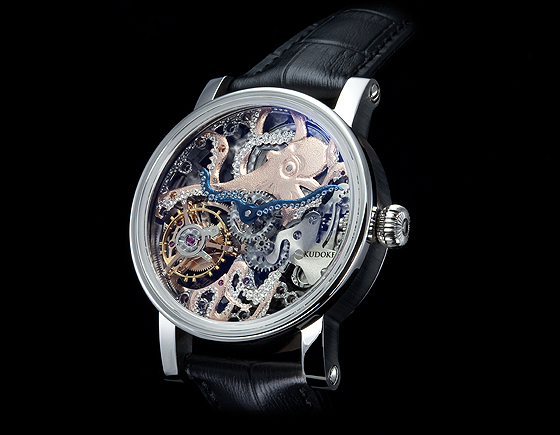
Like Valerii Danevych, Konstantin Chaykin is self-taught, and he lives and works far from the traditional European watchmaking centers. However, Chaykin does not work with wood, and he does not work alone. Chaykin is the complete watchmaker, designing and producing a range of original and complicated wristwatches and clocks with a group of craftsmen in a state-of-the-art atelier in Moscow. Chaykin is an inventor who began repairing and restoring watches and clocks about 10 years ago. After mastering the intricacies of traditional movements, he began developing his own ideas. Today he has an impressive body of work that includes 10 patents. He is the only Russian member of AHCI (Horological Academy of Independent Watchmakers).
He is known for his complicated calendar pieces, including watches and clocks based on the Jewish and Islamic calendars, his Resurrection astronomical clock with Easter calendar, and his Lunokhod watch with its unique central moon-phase display. In 2008, Chaykin began working on his Levitas, a mystery watch much like Cartier’s Mysterious Hours. Chaykin introduced his model in 2011. This year, Chaykin showed a new and unusual piece that generated significant buzz. Called the Cinema, it contains an animation mechanism created as a tribute to Eadweard Muybridge, the 19th century photography pioneer who famously used his zoopraxiscope, an early type of projector, to prove that galloping horses do indeed lose all contact with the ground during each stride.
The Cinema’s case evokes a vintage projector. A large, round aperture at 6 o’clock provides a view of the animation, which is triggered by the pusher at 9 o’clock. The pusher activates a mechanism that spins a disk engraved with 12 images of a galloping horse. The disk spins, displaying each frame for 0.07 seconds, creating the appearance of a short movie of a galloping horse, in the style of Muybridge’s creation. The timekeeping and animation functions each has its own barrel, allowing the animation to run for 20 seconds. Price: €50,000.


This article first appeared in WatchTime’s October 2013 issue and has since been updated with new information.

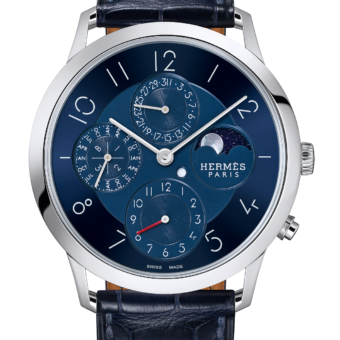

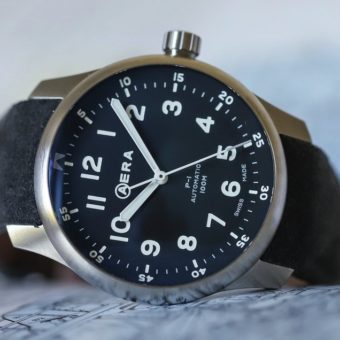

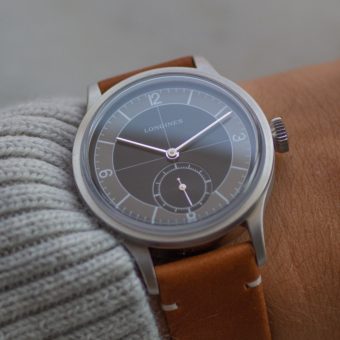

I have the opportunity to see the Cinema model working at the stand of Konstantin Chaykin during Basel World 2013. Although the watch is well made, the price (50,000 euros) seems to me very expensive, even considering the case made of solid white gold or platinum.